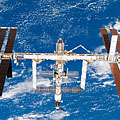| |||
ATV software was integrated into the whole ISS software ground testbed |
For the first time, the compatibility of the final Jules Verne Automatic Transfer Vehicle flight software has been successfully tested this month with the rest of the vast ISS flight software by international teams at the NASA Software Verification Facility (SVF) in Houston.
This ISS-level stage test, the so-called ’five-box’ test, is a new step where the ATV software is integrated into the whole ISS software ground testbed. It was conducted for 12 days over three weeks by some 43 engineers from NASA, ESA, Astrium, RSC-Energia and Boeing at the SVF Software Development and Integration Laboratory (SDIL), a few miles from NASA's Johnson Space Center. Another 30 people behind the scenes also provided support on site, in Russia and Europe.
For the ATV it is a trilateral test with the Russians playing a key role, as the Jules Verne re-supply spaceship will dock with the Russian Service Module. "The ATV Stage Integration Test was very successful and surpassed all of our expectations. This test demonstrated the integrated flight software functionality across the US segment, the Russian segment, and the ESA ATV vehicle for the timeframe in which the ATV is docked to the ISS. This success is the result of years of hard work and demonstrates the tremendous commitment of all three international partners, working together toward a common objective," said Susan Creasy, NASA ISS Avionics and Software Office Manager.
| |||
NASA's Sonny Carter Training Facility in Houston |
Test and verification of all ISS flight software is done at the SDIL, a world class infrastructure which houses over 800 computers. Its purpose is to provide a full confidence in the safety and efficiency between the different elements of the ISS for mission-critical software.
The Jules Verne ATV, which is scheduled to be launched in early 2008, is known as the ‘fifth box’, in this five-box test, which includes the two Fault Tolerant Computers (FTCs) of the Russian Service Module, the two MDM computers of the US Destiny Lab and for the first time, the ATV. Similar testing is required for ESA’s Columbus module and the Japanese Kibo module. On board the ATV, the FTC, which is the main 3-unit computer, and its flight application software play the role of a pilot that navigates the ATV mission.
| |||
The safety of the 220-tonne orbital outpost depends on smooth communication across the software |
The complexity of the different software and their compatibility will play a crucial role during the attached phases such as the re-boost operation, the debris avoidance manoeuvres and the desaturation of the Space Station’s gyroscopic attitude system while the ATV is attached to the ISS. The safety of the whole 220-tonne orbital outpost depends on smooth communication across the module software of the different partners. The flight code on the US side and the Russian side contains over four million lines of code and there are about one million lines of code in the various computers of the ATV spaceship.
| |||
Inside the Software Development and Integration Laboratory facility |
For those dedicated tests in the SVF, key elements of the real flight hardware, such as the ATV FTC, are connected to a high fidelity ATV simulator which reproduces the different scenarios and behaviour of the European spaceship, and a replica of the onboard data management system. Thanks to this complex infrastructure, with its interconnecting flight hardware, powerful computers and numerous pieces of software and synchronised simulation systems from all partners, it is as if the avionics bay of the ATV is actually flying in orbit with the rest of the ISS.
The facility in Houston will be continuously available to simulate on the ground, with the ATV software, any orbital scenarios of the five ATV missions planned between 2008 and 2015.
Notes for editors
Jules Verne is the first of a series of ATVs which will bring supplies including food, water, and fuel as well as experiment equipment to the crew on board the International Space Station. A crucial element of the ISS programme, the ATV will also re-boost the Station’s orbit to overcome the effects of residual atmospheric drag. After six months the ATV will undock and be used to dispose of Station waste during a guided and controlled destructive re-entry into the atmosphere high over the Pacific Ocean.







No comments:
Post a Comment